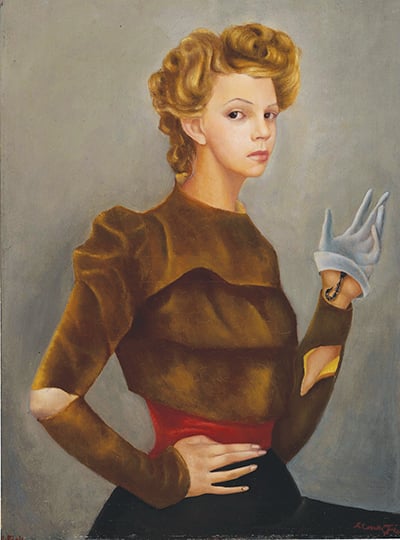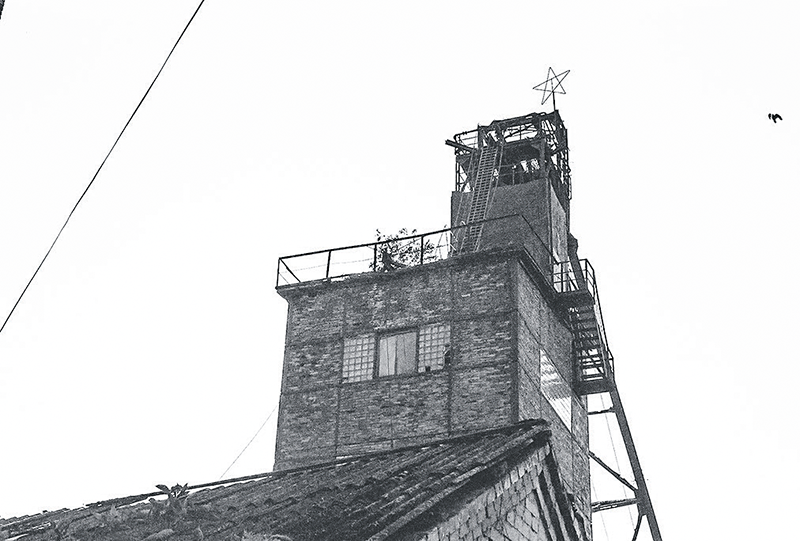
Self-portrait with Scorpion, by Leonor Fini, from Leonor Fini: Catalogue Raisonné of the Oil Paintings, which was published last year by Scheidegger & Spiess © Leonor Fini Estate, Paris/Artists Rights Society, New York City/ADAGP, Paris
I’m particularly fond of my forged Sisley, which an art restorer told me is only half bad. My grandfather purchased it—along with a sweet fake Renoir and an execrable Modigliani—while living in Buenos Aires in the early Sixties. Only recently did another friend, an art historian, explain that Argentina in the Sixties was an exhilarating hotbed of art forgers. In what felt like an instance of harmonic convergence, I then read María Gainza’s clever and captivating novel Portrait of an Unknown Lady (Catapult, $24), elegantly translated by Thomas Bunstead.
Gainza, author of the acclaimed 2019 novel Optic Nerve and herself an art critic, has taken the world of Argentinian art forgery as her subject, and wrought from it a richly layered fiction that often limns history. The narrator, referred to only as “Señorita M,” began her career as an art valuator, working with an established older woman she admired greatly, Enriqueta Macedo: “Whether I was helping her with the crossword, removing the bones from the fish she was about to eat, right up to tying her shoelaces when her arthritis was bad, all was pure poetry.” And indeed, Enriqueta was “an artist who had never produced a work of art; a work of art in her own right.”
But this same Enriqueta, an established authority in the field, has for forty years been laundering forgeries, granting certificates of authenticity to works painted by a group of artists based at the Hotel Switzerland, renamed the Hotel Melancholical by the poet Máximo Simpson. (This, at least, is no fiction: Simpson lived in the hotel for several years in the early Sixties.) The most lauded among them was a glamorous woman named Renée, whom Enriqueta had known since they studied at the Argentinean Fine Arts Academy. Together they formed the Melancholical Forgers, Inc., and even took commissions. One collector claimed that “Renée painted the best Figaris he owned.”
At some point in the Eighties, Renée vanishes. After Enriqueta’s death, the narrator, bereft, decides to trace the forger’s fate, and her journey goes in surprising directions. A former denizen of the Hotel Melancholical enlists her help in reviving the reputation of a mid-twentieth-century artist named Mariette Lydis, whose work Renée triumphantly forged (and whom Renée may have known personally). This undertaking, Operation Lydis, is conceived to bring money through auction to a former member of the Melancholicals now in a retirement home in Spain, “a sweet, elderly translator in her Balearic dotage.” The narrator meticulously prepares an auction catalogue of Lydis’s work, through which she tells the story of the artist’s flight from Nazi Austria to Argentina (the catalogue is included in its entirety, along with other deliciously false documents pertaining, for example, to a legal case involving an actual friend of Borges’s named Federico Manuel Vogelius).
The narrator, erudite and engagingly digressive, likens the Lydis effort to Alexander Gilchrist’s biography of William Blake, and recounts the exploits of an apparently fictional medium named Rogelio Nori. While in a trance, he paints Renoirs and, in fact, Sisleys. These are but a few of the book’s many artistic and literary references, which also include Oscar Wilde, the contemporary British poet D. J. Enright, and Julien Sorel, the protagonist of Stendhal’s The Red and the Black.
As the narrator interviews Renée’s former friends and acquaintances, it becomes clear that the forger is not to be found. One interlocutor explains that she had “something of the aura of a legend. A legend from just five minutes before,” and the narrator eventually realizes that “at root, for me, Renée was a mental state, a cloud on the horizon.” In the background looms Argentina’s dark years—a period of countless disappearances, which fell between the beatnik heyday of the Melancholical Forgers, Inc., and the moment in the late Eighties when Enriqueta last saw Renée. Inevitably, the ghost of Borges hovers over the enterprise, encouraging the slippage of realities—What is fiction? What is real? What is memory, if not a fiction?—and the slippage between authenticity and forgery. “Can a forgery not give as much pleasure as an original?” Enriqueta asks the narrator. “Isn’t there a point when fakes become more authentic than originals?”

Irish Sea from Manorbier, by Philip Sutton © The artist. Courtesy Sladers Yard Gallery, Bridport, England
Slippage of various kinds is central to Fintan O’Toole’s landmark history of contemporary Ireland. We Don’t Know Ourselves (Liveright, $32) may appear a daunting doorstopper of a book, but it is leavened by the brilliance of O’Toole’s insights and wit, and by the story of his own life, which he expertly intertwines into a larger historical narrative. O’Toole’s Ireland is, familiarly, a nation of grand myths and discordant realities. Writing about the 1983 abortion amendment to the Irish constitution and the subsequent Supreme Court ruling in 1988 that banned advice about abortion services overseas, he explains that “the point in all of this was not to change anything in the real world. It was to sustain the system of feigned ignorance.” This was, after all, a nation where, between 1970 and 2019, “at least a quarter of a million Irish women crossed the Irish Sea for a termination.”
This recurring condition of the “unknown known” pervades O’Toole’s account. “It was, mostly, about survival, the things people did to get by, the ways a society held itself together by preserving the barriers between what it knew and what it wanted to know.” This was true of aspects of the Catholic Church, from the sexual abuse of children to the offspring of supposedly celibate priests; of the scale of corruption and fraud in three-time Taoiseach Charles Haughey’s Fianna Fáil party; and of the Troubles themselves.
But even amid this national habit of “deliberate unknowing,” the evolution of the Republic in O’Toole’s lifetime was dramatic. At the end of the Second World War, two thirds of homes in rural Ireland were without electricity. At the time of the 1961 census, almost 75 percent of households did not have indoor plumbing. Moreover, in the mid-Fifties, “more than 80 per cent dropped out of formal education at fourteen, the legal school leaving age.” The Fifties were a lean decade in which an entire generation’s emigration threatened to strip the country of its future, and yet by the first years of this century, Ireland had become a cocky, global, immigrant-welcoming E.U. nation, floating on a precarious and doomed financial bubble.
The Catholic devotion of O’Toole’s childhood has also dwindled considerably, so that when he returns for his mother’s funeral to the large church where he was an altar boy, he finds it empty and eerily cavernous, “a factory of faith that had now become part of Ireland’s religious rustbelt, a temple of a lost culture.”
O’Toole, a product of these changes, with an education that enabled him to enter the middle class (he became a journalist and writer, though his mother was a cleaner and his father a bus conductor), sees the country’s shift with an eye that is simultaneously critical and compassionate. He returns repeatedly to Ireland’s ties to the United States, and astutely interprets moments such as John F. Kennedy’s 1963 visit. President Eamon de Valera addressed Kennedy “now as a proud father, now as a humble and grateful child,” while Kennedy’s words were at once “funny and ingratiating” and “comic and mocking.” The nation, simultaneously shamed by and proud of the Irish-American president, grasped that he was telling them that “if we Kennedys hadn’t got the hell out of here, even I’d be a no-good schmuck like you.”
O’Toole’s account ranges well beyond historical grandees to include minor celebrities such as Gay Byrne, an Irish television presenter, and the widespread Irish affection for western films and country music. He tells some jaw-dropping stories, among others, of the wild speculative narratives surrounding the Kerry Babies inquiry in the mid-Eighties, when a woman named Joanne Hayes was wrongly accused of murdering a newborn boy. He reminds us that in 1972, during the height of the Troubles, 1,853 bombs were planted and 497 people were killed. And yet, he says that if you were young at the time, as he was, “the big conflict was not the emerging disaster north of the Border. It was hair. The idea of letting it grow contained within it every possible kind of growth.”
Such frank moments punctuate this dense book, and these, more than strict reminiscence, constitute the personal nature of his history. O’Toole’s is a wildly ambitious project, one that accounts for inevitable partiality precisely through this invocation of the personal. It is a winning gambit.

Photograph © Yevgenia Belorusets. Courtesy New Directions
The Ukrainian photographer, artist, activist, and writer Yevgenia Belorusets is also concerned with partiality, and this concern underpins her short story collection Lucky Breaks (New Directions, $14.95), beautifully translated by Eugene Ostashevsky. Interspersed with her photographs, the stories—open-ended, fragmentary—serve a particular function in the artist’s attempt to document the ongoing Russo-Ukrainian war. As she writes in an introductory note,
photographs and words . . . collide, neither given the chance to explain or to illustrate the other. Their interlocked coexistence doesn’t allow any one idea, any one voice—especially the author’s—to dominate.
A near-invisible narrator recurs, and most pieces have women as their protagonists. Many of them have been displaced by the war, often to Kyiv from areas with heavy fighting in 2014. The scale of their worlds is largely domestic, but through Belorusets’s lens, small actions and encounters take on the qualities of myth. In “The Seer of Dreams,” a woman works as a waitress in her friend’s café, where “no one discussed terrible, heavy, or frightening things. Politics was forbidden.” Instead, a “tested company of friends” meets there weekly to hear the waitress recount her dreams. In “The Woman with the Black, Broken Umbrella,” the protagonist has “moved to Kyiv from a region where the war raged—but here, against any common sense, she continued with her wartime habits, her wartime tricks of desperate intercourse with objects,” including the hapless umbrella against which she rails violently, calling it, among other things, “you bastard, you abortion.”
Trauma lingers in the interstices of the everyday, only sometimes announcing itself. The effect, shocking, can also take on a register of searing dark comedy. In “Lena in Danger,” the narrator recalls her grandmother’s village with sentimental expostulation: “What a village it once was! Flourishing, light-filled, colorful, deep in the forest!” Now, she continues with a similar breathlessness, suicide is “the only field where youth can show what they’re made of, apply themselves, and exercise their imagination. Suicide—the one thing they can make theirs.”
In another disconcerting juxtaposition of the old and the new, the protagonist of “Elena” lives in one town and works in another some distance away, and speaks frequently to her beloved mother, who represents a dying way of life. Suddenly, she “felt she loved her so much that she couldn’t endure talking to her anymore. She thought that even the briefest conversation would be unbearable.” She throws her cell phone into a fountain, and asks to work seven days a week in the restaurant where she’s employed. The incident is small but dramatic, its significance enormous and heartrending. We apprehend Elena’s struggle, and her simultaneous grief and liberation, in a moment when only total severance from the past is possible.
The balance of myth and mundanity alters from story to story. Some, like “The Woman Who Caught Babies into a Mitt,” evoke traditional folktale, while others, particularly the trio of stories that involve a character named Andrea, are rooted in the everyday. Most hover in between. The effect is rather as if Isaac Babel and the Belarusian journalist Svetlana Alexievich had offspring.
“The Stars” is one of my favorites, narrated by a woman in the strange aftermath of war. “While the war was going on I felt calm, because I was living from one shelling to another. I wasn’t living day by day, but minute by minute and hour by hour,” she explains.
Having hidden for a long time in the basement, believing wild rumors—for example, that Canada has waged war against Ukraine—the narrator takes her first walk outside after being prompted by a horoscope (“Scorpio was safe tomorrow from noon until almost evening”) and encounters a fellow Scorpio. But now that the shelling has ceased, “the horoscope keeps giving the same recommendations, the wording unchanged, but we no longer understand it.” The stars, too, are the same: they “used to be on our side,” she reflects, but now “the sky does whatever the sky wants.” Where once she lived in a world of signs and wonders, now “there’s nothing happening.” As urgency has lifted, the signs no longer signify; she is abandoned.





























































































